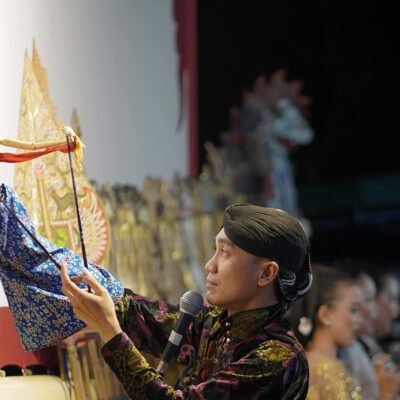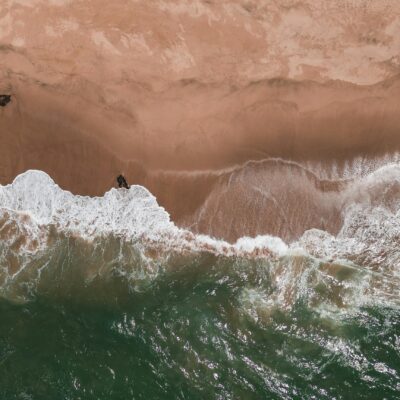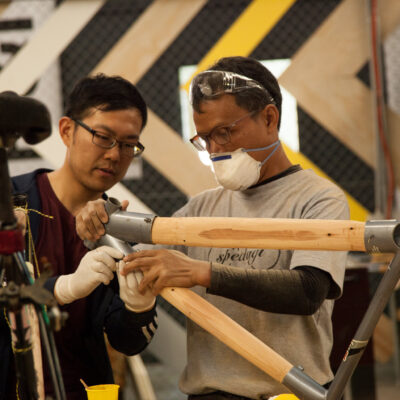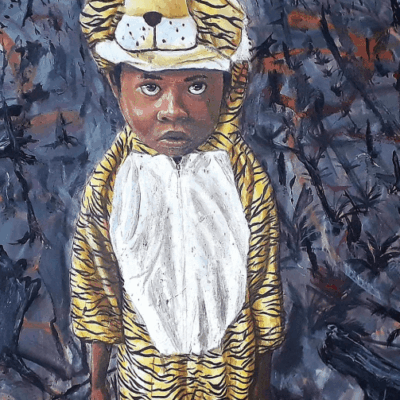Elia Nurvista is an Indonesian artist who is passionate about the political, economic and cultural meaning of food.
She explores the mass production and consumption of food and anthropogenic disaster through a wide variety of media, including raw materials, fabric, performance and video.
She is currently undertaking a 10 month residency in Florence, Italy, working on issues related to commercial palm oil production in Indonesia and its global consumption.
She spoke with Melbourne Asia Review’s Managing Editor, Cathy Harper.
Your current work is focused on the politics and economics around palm oil and its production, such as environmental destruction, worker exploitation and land disputes with Indigenous communities. Can you talk about the issues as you see them and how you represent this in your work?
I’ve been working a lot with the politics of food, problematising ingredients in food and our consumption of it. I’ve previously worked on the politics of the production and consumption of rice; and the history of sugar plantations, forest agriculture and Dutch colonialism, violence and extractivism.
I’m currently working on issues around palm oil. Indonesia is the biggest producer of palm oil and in the mainstream media it’s always framed as economic development that’s good for the country. But in grassroots media and by activist NGOs it’s about extractivism and Indigenous people who are living on the land who are affected by the palm oil plantations, as well as migrant workers from elsewhere in Indonesia who are sent to the plantations.
My father’s family, for example, came from Kalimantan on the island of Borneo. During the boom years of forest clearing and the expansion of extractive industries, the opening of forests created new economic opportunities. My grandfather ran a small grocery shop that sold everyday necessities such as rice and other staples to the growing number of workers in the area. The influx of people and resources allowed his business to thrive, enabling the family to save money and eventually move to Jakarta in search of better infrastructure and education.
Borneo was long imagined as a vast frontier of endless ‘no man’s land,’ a space to be exploited for its resources rather than developed for its people. Meanwhile, Java, overpopulated and heavily cultivated, stood in contrast. The government’s transmigration program was established to ‘balance’ this demographic disparity, sending people from Java and other islands to so-called underpopulated regions such as Kalimantan. But this policy also generated friction between newcomers and local communities, who often saw migrants gaining access to land without understanding how to live with it.
I have a food study group called Bakudapan, a collective, to bring solidarity between groups of people who are marginalised by extractive industries such as mining and tourism and plantations. It’s an opportunity to know more about the Indigenous people who have had to fight for their land and how plantations have come very slowly and quietly. It’s not dramatic like you might see in a national newspaper, but it’s happened.
It’s interesting that palm oil production is not a recent thing in Indonesia and has been affecting people in various ways for quite some time.
Yes, but palm oil is not endemic to Indonesia. It came from West Africa and the journey of the seed is also interesting because it’s involved with British and Dutch colonialism in Africa and in Indonesia. It became a global commodity for candles and as an alternative to animal fat in edible products such as margarine for consumption Europe. African plantations couldn’t fulfill this demand, so businesses went to Malaya and Sumatra in western Indonesia. At that time rubber and tobacco were the main plantations, but in 1840-1845 in a botanical garden in Bogor, they were trying to make palm oil adaptable to the climate. It took a long time but in 1911 there was the first plantation of palm oil and since then it’s been unstoppable.
At that time Indonesia was under the rule of Dutch colonialists but there were a lot of other investors from Belgium and France, Britain and the US, and they brought in migrant workers from China, India, and other parts of Indonesia to work on the plantations under repressive indentured labour.
There are clearly lots of issues related to palm oil production—colonialism, environmental damage, workers’ rights and Indigenous rights. How do you go about representing these issues in your work? What are your considerations for the aesthetic expression of your concerns and how are you trained in using them?
My first work on this subject matter was a sculpture made of ceramic, which was my first time working with ceramics. I was thinking how to represent this idea of an enormous, never-ending, unstoppable plantation. The whole work is 100 sculptures that look like palm trees, but which are also in the shape of human bodies because of the difficulty of resisting the integration of palm oil into the daily food of life. It’s not only people directly involved in the plantations, but globally we are all taking part in it as consumers. I’m interested in body parts becoming the palm of our body—the entanglement between human and non-human things such as plants and how it shapes our world.
Another work I did on textile—a batik that examines the history of palm oil and how it came from West Africa. The work is also about the history of the Batik that also comes from African cloth through the colonial trading paths. There are four panels telling the history of palm oil and using batik as technique, as a material, with its own related history.
I also make sculpture with palm oil wax candles and discarded material such as palm fronds. They are generally considered as waste products, but they are collected by economically marginalised people living by palm plantations who make an industry out of it by making baskets and window blinds. They are living on the periphery but they get what they can out of the huge economy that they’re not really part of. There are many paths and points of view around the palm oil commodity.
It’s interesting that you work with so many different mediums and products and produce such different pieces of art. Can you talk a bit more about that? How does that help you explain or engage with the complex issues around the production of palm oil?
It’s so different for every project, but if I have a pattern I usually start by asking ‘why’ and problematising everything. It’s object-based, but also interactive. There might be a performance or an event—a mix between the object base and then a platform that is more interactive. I’m working a lot with the food itself and the ingredients of food so I always go to the materiality and see what can I work with in relation to this. Maybe unconsciously, I want to work with the ingredient itself. When I’m thinking about sugar plantations I want to work with the sugar, or if it’s rice production I make something from the rice.
The materials have their own poetic way of telling a story and illustrating a journey, so I choose materials deliberately that are part of a changing dialogue. For example, one of the problems with the production of palm oil early on was slavery. This changed to indentured labour which was supposed to be different but was actually similar. There’s also the issues around ‘sustainability’ and ‘progressiveness’ which are sometimes just greenwashing and have the same logic of extracting from nature.
My individual artistic practice focuses largely on material, technique, and the presentation of objects, while my collective, Bakudapan, engages in various activities such as workshops, publications, and the creation of board games—formats that are more active and participatory.
As you say, we’re all part food production and consumption and we can’t really avoid it, so I wonder what you hope people who see your artwork take away from it?
My work is always around how to see complexity. In relation to palm oil, it’s a way to reflect on privilege—it aims to help people see their privilege. There are environmental campaigns, mostly in Western nations, to ban palm oil so it’s not used. But it’s not that simple.
At one stage, representatives from France in the European Union proposed what became known as the ‘Nutella tax’—a levy on palm oil, one of Nutella’s main ingredients. The European market wants to impose higher taxes on products that aren’t produced sustainably. They want plantations in Indonesia and Malaysia to be ‘sustainable,’ but the combination of EU import restrictions and the bureaucratic, often corrupt, certification procedures for ‘sustainable’ palm oil means that when products become less profitable, the price of palm kernels drops, leading to a decline in workers’ wages. Instant noodles also contain a lot of palm oil, but instant noodles are a cheap staple product for working class people in China. These campaigns are really related to class because other oils are more expensive and maybe if other oils were used many people couldn’t afford those products. Some of us have the privilege to say ‘no’ to these products but some people can’t. There are a lot of activists and NGOs fighting for this, but I choose another route to telling this story to the audience.
I’m also very aware that I’m part of this. I also have privilege over the people who are living in the plantations who don’t have any choice. I have cousins who own a small palm oil plantation. The big palm oil companies often involve smallholders who own small parts of the land and help manage the plantations through the INTI scheme (Perkebunan Inti Rakyat). For some local people this is the easiest way to earn a living and it gives them something to pass onto their children, but it’s not much when divided between all the offspring and it’s not profitable. The government says everybody can join this industry, participate in economic development and be able to buy a motorbike or a car and a lifestyle like Jakarta people.
Do you hope to influence government policy through your work?
Not directly. My main goal is for people to see the complexity of consumption and globalisation and not take their privilege for granted.
You will have heard of the saying that ‘you are what you eat’. I wonder what you think your work tells us about where ‘we’, as people, currently ‘are’.
I’m looking at things from the palm oil lens at the moment because it almost appears in every product. ‘You are what you eat’ is very classist—people who have a choice and options relating to buying materials that are less impactful on the planet. But I think there is always a way to go to the market and say we are not trying to ruin this product, but we should level the consumption. People who have more privilege have moral standards that are good, but I want audiences to also realise and acknowledge their privilege and the freedom to choose and to recognise that the world is this way. We are segregated by class and other privileges.




